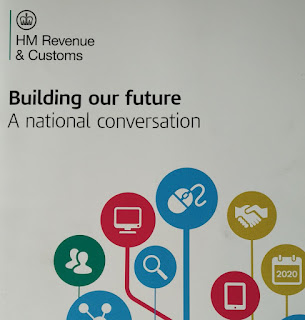Ten Years of Building Our Future
April 2024 marks ten years since HM Revenue and Customs breathlessly introduced their “national conversation” called “Building our Future.” Unveiled by chief executive Linda Homer, the one-sided conversation outlined the future shape of HMRC.
Government had set priorities to maximise tax revenue, improve services and reduce costs. “We are going to put customers at the heart of everything we do. That means redesigning our processes around them, rather than the taxes they pay or benefits they receive.”
Digitisation would automate many processes, cutting the need for some roles. ”We will continue to reduce in size and become even more highly skilled, and we will further consolidate into a small number of very large workplaces or Regional Centres.”
“We think it’s an exciting future, but we know it won’t be for everyone.”
It was followed up in November 2014 by “Building our Future 2: Continuing the Conversation.”
This led off with some finger-wagging from Linda Homer. “We’ve picked up that there has been speculation that we’re secretly planning to slim down to just 14 offices – which simply isn’t true. The fact is, we’re a long way from reaching any decisions about locations or numbers of sites.” Although, as fate would have it, the eventual decisions turned out to be very close to the rumours.
According to HMRC, regional Centres would allow staff to work across multiple lines of business and develop their careers. As an example, in the Leeds campus there were “only three people in the Senior Civil Service” and, “people have uprooted their families from one end of the country to the other, while others commute hundreds of miles.” So, ignoring the fact that many staff had already re-deployed due to earlier office closures, employment would be removed from communities in order to progress the careers of a minority of senior managers. “The needs of the few outweigh the needs of the many, “ as Mr Spock put it in one of the Star Trek films.
Hindsight gives a mordant bite to the disclosure that while some teams said they could support more homeworking, that wasn’t HMRC’s view of the future: “businesses like Google and Yahoo require their people to go into the office to work, because they recognise the energy and creativity that comes from having people work together physically in the same location.” Of course, even Building our Future couldn’t predict Covid.
Technology would improve compliance work in the brave new future. Admitting that the two computer systems which handled most compliance cases, “didn’t work as well as they should have done, and we didn’t listen properly or act fast enough when you told us, ” the project team had now designed new improved versions. In addition, “we’ll encourage customers to self-serve and will make it much harder for people to get things wrong.”
At this point HMRC had improved performance, answering 79% of calls on average across the year and turning 83% of post round within 15 working days. HMRC brought in a record £500 billion in tax revenues with £29.3 billion from compliance work.
HMRC senior management admitted that, “We’re still not very good at putting ourselves in our customers’ shoes – really seeing things as they do. Yet we know that’s something our frontline people are really good at.” But that didn’t mean holding on to them all.
Although the 2014 budget had given HMRC extra work and more demanding targets they had still got rid of over 2000 long term staff on voluntary redundancy “We know it’s been a shock for people, but we don’t think it’s right …to keep them in limbo.”
For those who stayed, or for the cheaper staff who’d just been taken on, there were new improved (cheaper) methods of training. Based on the theory that 70% of knowledge comes from on-the-job experience, 20% comes from interactions with colleagues and just 10% from courses and studying, the new approach was about building know how. “for example if your washing machine needs a new hose you might look at a You Tube video to find out how to fit it – you don’t need to know how it was built or how to change the drum.”
In the future the ‘once and done’ approach where customers only have to contact helplines once to get their issue resolved, would prevail “although phone contact will be starting to drop off, with more people using web chat or not needing to call in the first place as our help and support material is improving. By 2020 HMRC would have “far fewer people doing manual processing or dealing with customer post and phone contact.” All customer data would be shared across HMRC: “When customers contact us, it will feel as though we’re picking up a conversation with them where we left off last time."
As an example, Building our Future gave us “customer journeys” for people like Vera, who ran a small textile business selling her own designs through Etsy. By 2021 algorithms would spot increased sales in her Self Assessment return, triggering the Customer Relationship Management tool to send Vera information about when and how to register for VAT. Vera reflects that: “Government seems to be really organised these days. HMRC’s services…really helped me to understand what I needed to do for VAT and importing goods. The whole process is so easy that I will try to import and export more.”
Of course, the people behind Building our Future couldn’t be expected to know about Brexit or Covid. And they were really surprised that so many experienced staff took their offer of voluntary exit rather than face a long daily commute to their glistening new regional centres. And of course, they couldn’t be expected to know that IT wouldn’t deliver. But – in the words of Boris Johnson – them’s the breaks.




